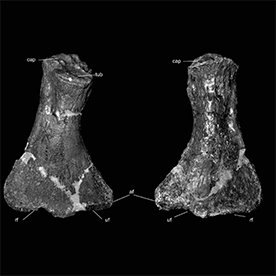PLESIOSAURS (DIAPSIDA, SAUROPTERYGIA) FROM LATE CRETACEOUS (LATE CAMPANIAN–EARLY MAASTRICHTIAN) MARGINAL MARINE ENVIRONMENTS FROM NORTH PATAGONIA
DOI:
https://doi.org/10.5710/PEAPA.13.05.2015.105Abstract
During the late Campanian and early Maastrichtian, Northern Patagonia suffered the first stage of the Atlantic marine ingression that reached the Neuquén Basin. The Allen and La Colonia formations show the early stages of this change, and were deposited in a complex asso- ciation of marginal marine environments, including coastal and marine deposits (i.e., flood plains, estuaries and lagoons). The plesiosaurs from the Allen and La Colonia formations included at least three species, each with a distinctive morphotype, representing a high diversity in the Late Cretaceous. The only species that preserved cranial material, Sulcusuchus erraini Gasparini and Spalleti, is a strange polycotylid characterized by the presence of deep grooves in the rostrum and mandible. The other two species correspond to aristonectine and non-aristonectine elasmosaurids. The former are distinguished by relatively large skulls and a high number of teeth compared to other elasmosaurids, whereas the non-aristonectine elasmosaurids are characterized by their relatively small body sizes, despite being adult specimens.

Downloads
Published
Issue
Section
License
Copyright (c) 2015 Publicación Electrónica de la Asociación Paleontológica Argentina

This work is licensed under a Creative Commons Attribution-NoDerivatives 4.0 International License.
Authors retain copyright and grant the journal right of first publication with the work simultaneously licensed under a Atribución/Reconocimiento 4.0 Internacional that allows others to share the work with an acknowledgement of the work's authorship and initial publication in this journal.















